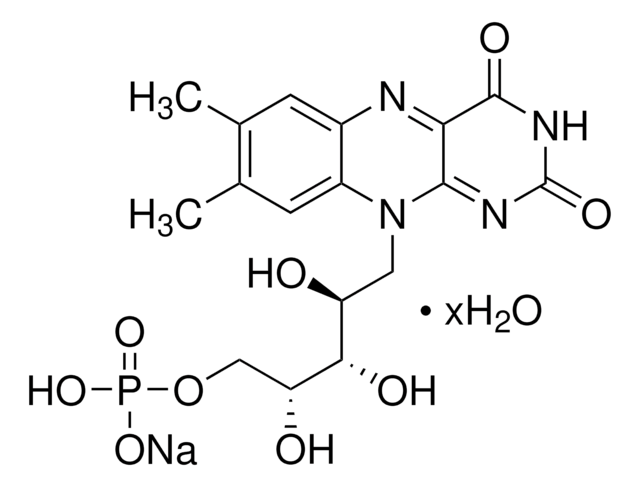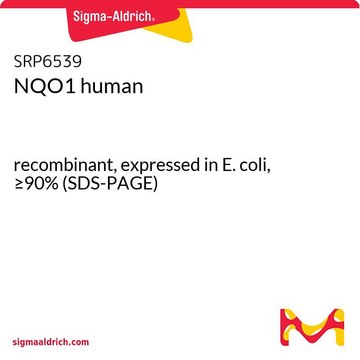F1392
Riboflavin 5′-monophosphate sodium salt hydrate
suitable for electrophoresis, suitable for acrylamide photopolymerization, ≥70%, powder
Sinônimo(s):
FMN-Na, Flavin mononucleotide, Riboflavin 5′-phosphate sodium salt
About This Item
Produtos recomendados
Nível de qualidade
Ensaio
≥70%
forma
powder
atividade óptica
[α]20/D +37 to +42°, c = 1.5 in 5 M HCl(lit.)
técnica(s)
electrophoresis: suitable
solubilidade
H2O: soluble 50 mg/mL, clear, orange
ε (coeficiente de extinção)
12.5 at 445 nm at 1 mM
adequação
suitable for acrylamide photopolymerization
atividade externa
Protease, none detected
temperatura de armazenamento
−20°C
cadeia de caracteres SMILES
O.[Na+].Cc1cc2N=C3C(=O)NC(=O)N=C3N(C[C@H](O)[C@H](O)[C@H](O)COP(O)([O-])=O)c2cc1C
InChI
1S/C17H21N4O9P.Na.H2O/c1-7-3-9-10(4-8(7)2)21(15-13(18-9)16(25)20-17(26)19-15)5-11(22)14(24)12(23)6-30-31(27,28)29;;/h3-4,11-12,14,22-24H,5-6H2,1-2H3,(H,20,25,26)(H2,27,28,29);;1H2/q;+1;/p-1/t11-,12+,14-;;/m0../s1
chave InChI
BHRVCJBIICJWTH-APQIITSESA-M
Procurando produtos similares? Visita Guia de comparação de produtos
Aplicação
- to study its mechanism of inhibition of mutagenicity of a benzo[a]pyrene 7,8-diol 9,10-epoxide, a carcinogenic metabolite of benzo[a]pyrene
- along with flavin adenine dinucleotide for reactivation of the enzyme that catalyzes the oxidation of pyridoxamine to pyridoxal in a study
- to study the reduction of polymeric azo and nitro dyes by intestinal bacteria
- to study the effect of FMN on ferrisiderophore reductase activity in the cytoplasmic fraction of Agrobacterium tumefaciens.
Ações bioquímicas/fisiológicas
FMN is suitable as a photopolymerization reagent in polyacrylamide gel electrophoresis (PAGE) by forming free radicals in aqueous solution in the presence of light. FMN photodecomposes to leucoflavin. No free radicals are formed in the absence of oxygen, but traces of oxygen allow for leucoflavin to reoxidize with free-radical generation. The catalysts, tetramethylethylenediamine (TEMED) or 3-dimethylaminopropionitrile (DMAPN), are commonly added to speed up the free radical formation. Free radicals will cause acrylamide and bis-acrylamide to polymerize to form a gel matrix which can be used for sieving macromolecules. FMN is commonly used in the stacking gel for non-denaturing PAGE because native proteins can be sensitive to persulfate ions from ammonium persulfate. Another advantage of FMN over ammonium persulfate is that it will not start polymerizing until the gel is illuminated.
Código de classe de armazenamento
11 - Combustible Solids
Classe de risco de água (WGK)
WGK 1
Ponto de fulgor (°F)
Not applicable
Ponto de fulgor (°C)
Not applicable
Equipamento de proteção individual
Eyeshields, Gloves, type N95 (US)
Certificados de análise (COA)
Busque Certificados de análise (COA) digitando o Número do Lote do produto. Os números de lote e remessa podem ser encontrados no rótulo de um produto após a palavra “Lot” ou “Batch”.
Já possui este produto?
Encontre a documentação dos produtos que você adquiriu recentemente na biblioteca de documentos.
Os clientes também visualizaram
Nossa equipe de cientistas tem experiência em todas as áreas de pesquisa, incluindo Life Sciences, ciência de materiais, síntese química, cromatografia, química analítica e muitas outras.
Entre em contato com a assistência técnica




